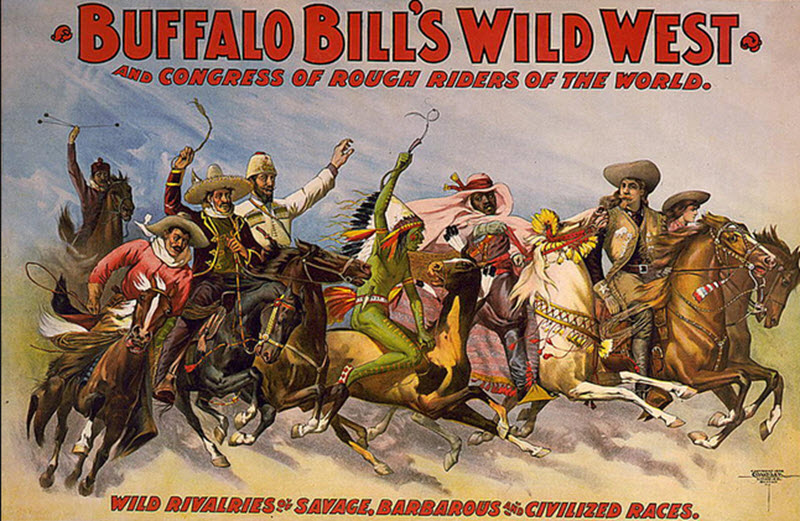Wild West Shows
From the 1870s and until the end of the 1920s, traveling vaudeville groups marketed as Wild West Shows were popular throughout the United States, and some of the groups also traveled abroad.
The earliest shows were theatrical stage productions, and from these open-air shows evolved. The Wild West Shows depicted a romanticized version of frontier life, with cowboys, army scouts, Native Americans, outlaws, etc. Some shows also included animals.
For many spectators, the Wild West shows were their main exposure to the idea of the Wild West.

History
After the end of the American Civil War in 1865, dime novels depicting frontier life in the American West became a popular feature in stores throughout the country. These little books were cheap to buy and could therefore reach a big audience. Stories about “the wild west” would also appear in magazines – sometimes as serialised stories that would span multiple issues.
These stories helped propel mainstream interest in the wild west, paving the way for the early Wild West Shows. One novel in particular – one written by Ned Buntline and published in 1868 – would come to have a huge impact. This was a novel about a bison hunter, army scout and guide named William Frederick Cody – more well known under his nickname Buffalo Bill. Buffalo Bill wasn’t a pure figment of Buntlines active imagination; he wrote the novel “Buffalo Bill, the King of Border Men” after meeting the real William Cody on a train from California to Nebraska.
In 1872, the theatrical production “The Scouts of the Prairie” debuted in Chicago, a show based on Buntlines novel. The show featured Cody, Buntline, John Baker Omohundro (“Texas Jack”) and the ballerina Giuseppina Morlacchi. The show toured the American theater circuit for two years.
In 1874, when Buntline had already left the group, Cody founded the Buffalo Bill Combination. Soon, James Butler Hickok (“Wild Bill Hickok”) joined the group to headline a new play named “Scouts of the Plains”, but he never adapted well to being on the stage and was released from his contract a few months later after shooting out a spotlight that focused on him during a performance.
In various configurations, western-themed performance groups headed by Buffalo Bill continued to tour the country, bringing wild west performances to cities, towns and villages near and far. In 1883, he founded the famous Buffalo Bill’s Wild West, an outdoor attraction that toured annually and contained trick performances, shooting displays, rodeo events, theatrical reenactments of battle scenes, captive-kept wild animals from western USA, and various stock characters from frontier life.
Today, Buffalo Bill’s Wild West – which last until 1915 – is hailed as the archetypal Wild West Show.
Beyond the Wild West show
Even though the travelling vaudeville Wild West show largely fell out of favour with the public towards the end of the 1920s, the interest in frontier life that it had helped propel remained and was channelled into western movies, modern rodeos, circuses and similar types of entertainment. Eventually, western-themed TV-shows also appeared.
